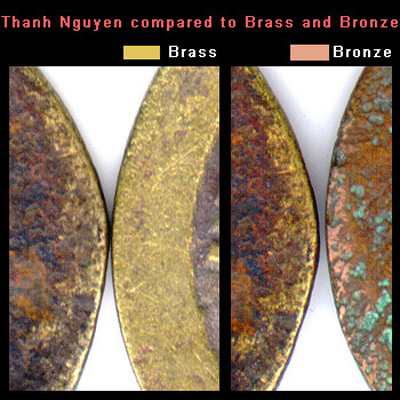
| Forgery, Wrong kind of metal and wrong calligraphy Thánh Nguyên Thông Bảo, 聖元通寶 This second example of a Thánh Nguyên Thông Bảo forgery is a good study in metallurgy. The calligraphy tries to copy the style of the real reign title coin, shown at the top of the group of rubbings below, but the imitation is not so good. The coin is not new and some argue that it is just another variety from the same time. However, a careful study of the metal and the casting shows that the coin cannot come from 1400, the time of the real coin. The fundamental error is that the coin is made of brass instead of bronze. Brass was not known at the time and therefore was not used in coins. Brass was first used extensively for coins more recently in the late Chinese Ming and early Chinese Qing dynasties. Calligraphy The problems with the calligraphy are seen by comparing the rubbings of three coins on the right. The suspicious piece in the middle is compared to the genuine Hồ dynasty Thánh Nguyên Thông Bảo on the top and Thiệu Nguyên Thông Bảo on the bottom. The writing style of the first and third coins is the same and appears to be from the same hand. The writing style of the second piece is imitative of the other two but all four characters on the forgery are different from the same characters on the real coin. The most noticeable difference is the character Nguyên, which is very beautifully written on both of the real coins. Their horizontal strokes flare out a little wider at the ends and the right leg has a small break, or knee, near the top. None of this is true of the suspicious coin where the Nguyên is thin and formless as if it was written by an amateur, which it probably was. Based on calligraphy alone the middle coin should be a forgery. Metallurgy The real proof of forgery is that the coin was wrongly made of brass, a fairly common mistake. The metallurgy can be seen in the group of images on the right. The two rims in the left image compare the suspicious piece (left rim) with a brass coin of the Qing dynasty (right rim). The two rims in the right image compare the suspicious piece (again left rim) with a bronze Vietnamese coin from about 1400 AD (right rim). Both bronze and brass are copper based alloys but bronze has a pinkish color while brass is very yellow. Vietnamese coins of the Hồ dynasty, and even the later Lê dynasty, cannot be made of brass because it did not exist at the time. Casting Final evidence is seen in the casting. The image at the bottom shows part of the coin's reverse outer rim where the front and back parts of the mold were misaligned. Such misalignment is not uncommon and is even seen on the genuine Thánh Nguyên coin in the rubbing on the previous page. However, the reverse rim of the forgery is different because it does not go all the way to the edge of the coin, which causes the front rim to overhang the reverse rim. An overhang of this degree is rarely seen on official coins, and is not seen on the reverse of the genuine Thánh Nguyên. The reverse rim of the genuine piece extends to the edge of the coin even though the reverse is misaligned at least as much as the forgery. Cast forgeries with misaligned rims often have similar overhangs. |
    |
||
| (1)
Bronze is an alloy of copper and tin with superior properties to pure
copper. Bronze often occurs naturally and customized alloys of bronze
became possible after the widespread refinement of tin in about 1800BC.
Brass is an alloy of copper and zinc. It also occurs naturally on
occasion, and was used as early as Roman times, around 10BC. However,
the production of customized alloys of brass occurred late because zinc
was not recognized as a metal or refined until about the 14th century
in India and the 16th century in Britain. |
|||